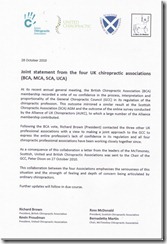Chiropractors at War with their Regulator, the GCC
 From Richard Lanigan’s blog, we learn that the head of the four chiropractic associations have written to the GCC to state that their members have no confidence in their regulatory abilities. Richard Brown, President of the British Chiropractic Association has written the letter, co-signed by Ross McDonald, Kevin Proudman and Bernadette Martin, the Presidents of the Scottish Chiropractors, the United Chiropractic Association and the McTimoney Chiropractors respectively.
From Richard Lanigan’s blog, we learn that the head of the four chiropractic associations have written to the GCC to state that their members have no confidence in their regulatory abilities. Richard Brown, President of the British Chiropractic Association has written the letter, co-signed by Ross McDonald, Kevin Proudman and Bernadette Martin, the Presidents of the Scottish Chiropractors, the United Chiropractic Association and the McTimoney Chiropractors respectively.
The letter notes that the BCA recorded a vote of no confidence in the GCC at their AGM. The Scottish Chiropractors also passed a vote of no confidence, and the others held an online survey to judge their members feelings.
The GCC is a statutory regulator. That is, anyone wishing to practice as a chiropractor in the UK must be registered and abide by their code of ethics and practice. So, what is causing this concern?
Well, a big part of it is that hundreds of chiropractors are now under investigation by the GCC for making misleading claims on their websites. This was a direct result of Richard Brown and the BCA deciding to sue the writer Simon Singh for libel after he wrote in the Guardian that the BCA were “happily promoting bogus treatments” for children’s ailments. The law suit ended in humiliation for the chiropractors as they were forced to back down and repay Simon’s costs mounting to hundreds of thousands of pounds.
That was not the only bad effect of this misconceived legal case. The abuse of law outraged thousands of people and it is now likely that the law will change as a result of this. (Buy your Geek Calendar to support the libel reform campaign here.) A number of individuals decided that so many BCA chiropractors were making these unfounded and exploitative claims that they submitted hundreds of official complaints to the GCC about their conduct. Those complaints are now under investigation. The complaints caused mass panic amongst chiropractors with the associations ordering their members to take down their web sites for fear of their bogus claims being complained about.
Richard Brown, the President of the BCA, is also under investigation for presenting misleading information to the public about the effectiveness of chiropractic in children.
And with the new formation of the Nightingale Collaboration, which sets out to deliberately challenge misleading claims from practitioners of alternative medicine through regulation and legal means, the other chiropractors must be quaking in their boots that they will essentially be silenced from pretty much any form of advertising or risk a disciplinary hearing.
And so, the regulator, which has given the chiropractic trade the so-much-desired air of respectability, is being directly attacked by its own registered members. This is not surprising. It was a big mistake to give official state recognition and regulation to a discredited, superstitious and pseudoscientific form of medical treatment in the first place. Chiropractic theory has been shown to be nothing but mystical whimsy and the effectiveness of their special back rubs has now only been shown to be marginal for lower back pain – about as good as a few paracetamol. So, when the demands of an evidence-based regulator are brought down on a cult-like pseudomedical trade, only tears could follow.
What is ironic here is that when regulation was first proposed for chiropractic, one of the conditions was that the trade should be unified and have a single voice, as is characteristic of a profession. That unified voice never really appeared and the resultant agreements were a political fudge in order to gain the prize of state recognition. There were many issues, but they boiled down to all mainstream chiropractors hating the McTimoney’s, and the progressives hating the conservatives. That is why there are four associations that represent chiropractors and not just one. Probably, for the first time we are seeing all UK chiropractors acting with one voice: and it is against the regulator that they so desired twenty years ago.
The House of Lords recommended that in order for chiropractors to be suitable for statutory regulation, the following conditions should apply:
-
- The profession must be mature
- It must have one governing body
- It must be based on a systematic body of knowledge
- It must have recognised courses of training
- It must be able to demonstrate efficacy. (Hansard, 1985).
It is hard to say that key conditions were ever met. It is not a mature profession as it cannot even agree on what the essential nature of their profession is. The core concept of the chiropractic subluxation, that drives their philosophy and practice, has been rejected by the regulator,
There is no clinical research base to support claims that the chiropractic vertebral subluxation complex is the cause of disease or health concerns.
This has indeed caused much anguish amongst the trade and is almost certainly at the root of their disquiet with the GCC, as many of them have a near religious belief in subluxations.
The “systematic body of knowledge” has also been shown to be derisory. At the heart of the BCA claim against Simon Singh was that there was a ‘plethora’ of research to demonstrate that chiropractors could treat childhood ailments such as colic. When this was finally published, this ‘plethora’ was quickly shown to be nonsense by the BMJ, where the editor, Fiona Godlee said “[The] demolition of the 18 references is, to my mind, complete.”
Subsequently, the GCC commissioned a report into the evidence base for chiropractic so that it could determine what claims they would be allowed to make. The Bronfort report showed that for a vast range of common claims for chiropractic treatment, the evidence base was very shoddy.
The Universities, who underwrite the degree level courses that allow chiropractors to be regulated should be ashamed of their money grabbing complicity in the deception that is much of chiropractic. For example, the University of Wales provides the academic accreditation for the McTimoney College in Abingdon – a college that offers MSc’s in paediatric chiropractic and also in Animal chiropractic, where completely unsubstantiated claims run unfettered. Students, who enrol in these courses, are misled into believing that what they are learning has an academic status that cannot be justified by reason or evidence. A prominent member of the Education Committee at the GCC is also the Principle of the McTimoney College and was recently honoured with the first University of Wales Personal Chair for her work at the college and so can now call herself ‘Professor’.
Now, this blog has opposed the statutory regulation of superstitious medical practices, such as homeopathy, and it would be hypocritical of me if I thought chiropractors should be an exception. Even if it would be harder to police the claims of chiropractors, were they to be de-regulated, at least they would lose their imprimatur of state recognition and probably the degree level courses underwritten by the universities.
In the long run, I think that would better protect people. There would be fewer reasons to confuse them with medically trained professionals. And students might not be drawn into their educational courses, wasting tens of thousands of pounds on a pseudoscientific education.
Perhaps it is time to rethink the whole idea of regulation of chiropractors.








550 comments